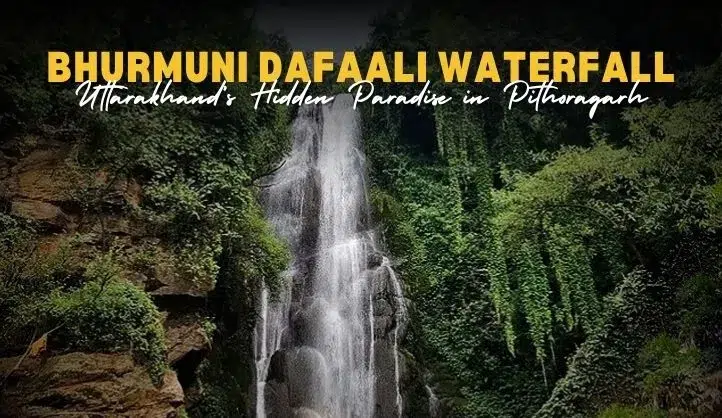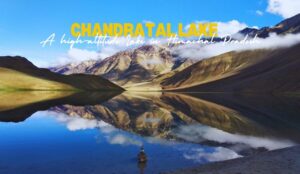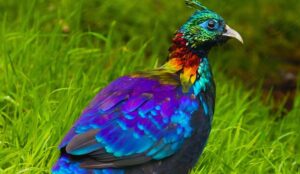In the heart of Uttarakhand’s Pithoragarh district lies a natural marvel that’s still untouched by mass tourism, Bhurmuni Dafaali Waterfall. Nestled in the serene village of Jagtar, this two-tiered waterfall is surrounded by dense forests, rolling meadows, and the kind of tranquility that only the Himalayas can offer. Often called the “Mini Kashmir of Uttarakhand,” Bhurmuni Dafaali is a destination that blends adventure, serenity, and cultural richness into one unforgettable experience.
Location and How to Reach
Bhurmuni Dafaali Waterfall is located in Jagtar village, approximately 17 kilometers from Pithoragarh town, along the scenic Chandak Road. The journey itself is a visual treat, with pine forests, terraced fields, and glimpses of snow-capped peaks.
- Last-mile access: The final 3 kilometers are a rough dirt track, best navigated by SUV or local jeep.
- Trek to the waterfall: A 2-kilometer forest trail from Jagtar village leads to the waterfall.
- Best time to visit: June to September for monsoon magic; December to February for winter enchantment.
Despite the modest infrastructure, the route offers a raw, immersive experience that’s perfect for offbeat travelers.
The Waterfall’s Structure – A Two-Tiered Marvel
Bhurmuni Dafaali is not just a waterfall, it is a two-tiered spectacle of nature’s artistry.
- Upper tier: A dramatic 70-meter drop that roars during monsoon, creating mist clouds and echoing through the valley.
- Lower tier: A gentler 30-meter descent, ideal for photography and quiet reflection.
Together, they form a cascading flow of over 100 meters, surrounded by thick forest and moss-covered rocks. The sound of rushing water, the scent of pine, and the cool breeze create a multisensory experience that’s both grounding and exhilarating.
Monsoon Majesty: June to September
During the monsoon, Bhurmuni Dafaali comes alive. Rain-fed streams swell the waterfall’s volume, turning it into a thunderous cascade that dominates the landscape.
- Visual appeal: The waterfall is framed by lush greenery, with water droplets catching the light like diamonds.
- Atmosphere: The air is thick with mist and the scent of wet earth, offering a deeply immersive experience.
- Ideal for: Nature photographers, monsoon trekkers, and those seeking dramatic landscapes.
The trail may be slippery, but the reward is a view that feels like stepping into a Himalayan fairytale.
Winter Enchantment: December to February
In winter, Bhurmuni Dafaali transforms into a frozen wonderland. The waterfall partially freezes, forming glistening ice formations that sparkle under the sun.
- Landscape: Snow-dusted trees, icy cliffs, and a serene silence that blankets the valley.
- Experience: Ideal for solitude seekers, couples, and photographers looking for ethereal shots.
- Temperature: Often drops below freezing—layer up and carry warm beverages.
This seasonal shift adds a magical dimension to the destination, making it a year-round attraction.
The Story of Its Discovery
Before 2020, Bhurmuni Dafaali was a well-kept secret. During the COVID-19 lockdowns, many locals returned to their villages. It was during this time that youth from Bhurmuni village rediscovered the waterfall and carved out a trail to make it accessible.
- Community effort: The trail was built with minimal resources, driven by local pride and a desire to share nature’s gift.
- Symbolism: The waterfall became a beacon of hope and renewal during a time of global uncertainty.
This grassroots discovery adds emotional depth to the destination—it’s not just a place, but a story of resilience and connection.
Trekking Experience: A Journey Through Wilderness
The 2-kilometer trek to Bhurmuni Dafaali is a gentle ascent through Himalayan wilderness.
- Trail features: Pine groves, wildflowers, chirping birds, and occasional glimpses of Himalayan peaks.
- Difficulty level: Easy to moderate; suitable for families, solo travelers, and beginners.
- Duration: 30–45 minutes depending on pace and weather.
The trek is not just a path—it’s a transition from the everyday to the extraordinary.
Why It is Called “Mini Kashmir of Uttarakhand”
Locals affectionately call Bhurmuni “Mini Kashmir” due to its cool climate, rolling meadows, and lush forests. The resemblance to Kashmir’s landscape is striking, especially during winter and monsoon.
- Visual parallels: Snow-covered trees, misty valleys, and alpine flora.
- Emotional resonance: A place where time slows down and nature takes center stage.
This nickname isn’t just poetic—it’s a reflection of the region’s untouched charm.
Homestays & Local Hospitality
While there are no commercial resorts, homestays in Jagtar and nearby villages offer authentic Kumaoni hospitality.
- Accommodation: Simple, clean, and surrounded by nature.
- Cuisine: Bhatt ki churkani, mandua roti, pahadi raita, and seasonal vegetables.
- Cultural immersion: Folk stories, local music, and traditional farming practices.
Staying with locals adds depth to your journey—it’s not just about seeing a place, but feeling it.
Nearby Attractions Worth Exploring
While Bhurmuni Dafaali Waterfall is the crown jewel of Jagtar village, the surrounding region of Pithoragarh offers a treasure trove of experiences that cater to nature lovers, spiritual seekers, and history enthusiasts alike. Here are the top nearby attractions that elevate your journey into a full-fledged Himalayan escape:
Jageshwar Temple Complex (Approx. 10 km)
A sacred valley of stone temples nestled amidst deodar forests, Jageshwar is home to 124 ancient shrines dedicated to Lord Shiva. The air here is thick with incense and mythology.
- Highlights: Intricate stone carvings, centuries-old lingams, and meditative ambiance.
- Best time to visit: Early morning for rituals or evening aarti.
- Emotional appeal: A place where time feels suspended and devotion flows like the river Jata Ganga.
Chandak Hills Viewpoint
Just a short drive from Bhurmuni, Chandak Hills offers panoramic views of the Soar Valley and distant Himalayan peaks.
- Activities: Sunrise treks, photography, and quiet picnics.
- Spiritual touch: Visit the Mostamanu Temple en route, dedicated to Lord Shiva.
- Why it matters: It’s the perfect spot to reflect, breathe, and let the mountains speak to you.
Pithoragarh Fort (Approx. 17 km)
Built in the 18th century by the Gorkhas, this fort stands as a sentinel over the valley, offering sweeping views and a glimpse into the region’s strategic past.
- Architecture: Stone walls, colonial-era remnants, and vantage points.
- Best time: Sunset, when the valley glows golden.
- Cultural depth: A reminder of the region’s layered history—from Gorkha rule to British colonialism.
Askot Musk Deer Sanctuary (Approx. 52 km)
A haven for Himalayan wildlife, this sanctuary is home to the elusive musk deer, as well as leopards, bharals, and a rich variety of birds.
- Experience: Forest trails, wildlife spotting, and eco-tourism.
- Ideal for: Nature lovers, conservationists, and photographers.
- Bonus: Stop at Dhwaj Temple en route, perched on a hilltop with mythological significance.
Patal Bhuvaneshwar Cave Temple (Gangolihat, Approx. 90 km)
A mystical underground temple believed to house 33 crore Hindu deities in its limestone formations. This cave is a spiritual and geological marvel.
- Ambiance: Dimly lit chambers, echoing chants, and surreal rock formations.
- Mythology: Said to be the abode of Lord Shiva and other celestial beings.
- Travel tip: Hire a local guide to understand the symbolic carvings.
Maharajke War Memorial
A solemn tribute to the soldiers of the 1965 Indo-Pak war, this memorial is surrounded by pine trees and silence.
- Why visit: To honor bravery and reflect on peace.
- Best time: Late afternoon for golden light and quietude.
Photography Tips
- Golden hour: Early morning light enhances mist and water reflections.
- Winter shots: Use a wide-angle lens to capture frozen cascades and snow-covered trees.
- Monsoon drama: Long-exposure shots with a tripod can capture the waterfall’s full force.
Don’t forget to carry extra batteries—this place will tempt you to shoot endlessly.
Final Thoughts
Bhurmuni Dafaali Waterfall is more than a destination, it is a story of rediscovery, community pride, and nature’s quiet grandeur. Whether you’re a trekker, photographer, or someone seeking peace away from the crowds, this hidden gem offers an experience that’s both grounding and inspiring. As tourism slowly unfolds here, now is the perfect time to explore it responsibly and help preserve its pristine charm.
FAQs About Bhurmuni Dafaali Waterfall
1. How do I reach the waterfall?
- Drive from Pithoragarh to Jagtar village (SUV recommended for the last 3 km).
- From Jagtar, trek 2 kilometers through forest trails to reach the waterfall.
- Local jeeps and guides are available for assistance.
2. What is the best time to visit Bhurmuni Dafaali Waterfall?
- Monsoon (June–September): For dramatic water flow and lush greenery.
- Winter (December–February): For frozen cascades and snow-covered landscapes.
- Avoid peak summer afternoons due to heat and dry conditions.
3. Is the trek to the waterfall difficult?
Not at all. The trek is easy to moderate, suitable for beginners, families, and solo travelers. It takes about 30–45 minutes depending on pace and weather.
4. Are there any entry fees or permits required?
No entry fee or permit is currently required. However, visitors are encouraged to respect local customs and avoid littering to preserve the natural beauty.
5. Are there homestays or accommodations nearby?
Yes, homestays in Jagtar and nearby villages offer authentic Kumaoni hospitality, local cuisine, and cultural immersion. Advance booking is recommended during peak seasons.
6. Can I visit Bhurmuni Dafaali Waterfall with children or elderly travelers?
Yes, but keep in mind:
- The final trek may be challenging for elderly visitors.
- Carry water, snacks, and walking sticks for support.
- Avoid visiting during heavy rains or icy conditions for safety.
7. Is Bhurmuni Dafaali safe for solo travelers?
Absolutely. The area is peaceful and welcoming. Solo travelers should:
- Inform locals before trekking.
- Carry a charged phone and basic supplies.
- Travel during daylight hours.
8. What should I carry for the trip?
- Trekking shoes or sturdy footwear
- Water bottle and snacks
- Raincoat (monsoon) or warm layers (winter)
- Camera or phone for photography
- Eco-friendly waste bags





